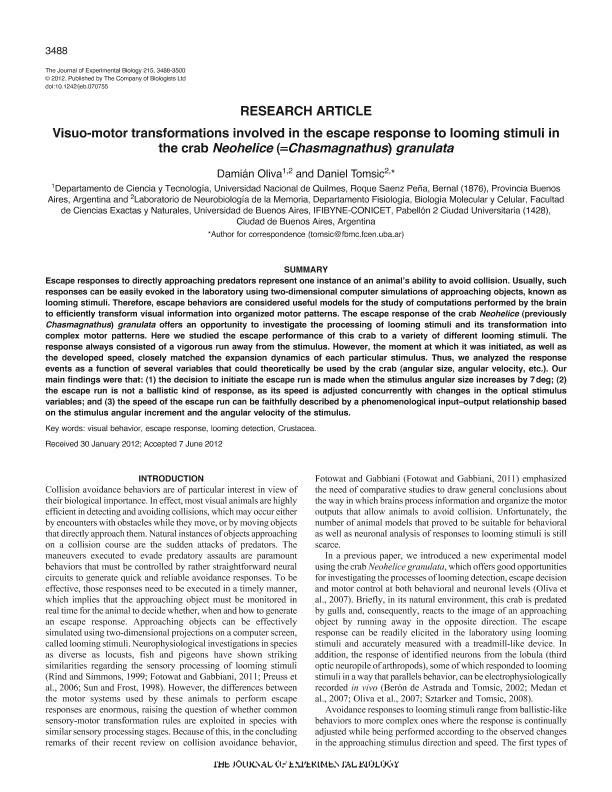Mostrar el registro sencillo del ítem
dc.contributor.author
Oliva, Damian Ernesto

dc.contributor.author
Tomsic, Daniel

dc.date.available
2017-07-12T20:33:42Z
dc.date.issued
2012
dc.identifier.citation
Oliva, Damian Ernesto; Tomsic, Daniel; Visuo-motor transformations involved in the escape response to looming stimuli in
the crab Neohelice (=Chasmagnathus) granulata; Company of Biologists; Journal of Experimental Biology; 215; -1-2012; 3488-3500
dc.identifier.issn
0022-0949
dc.identifier.uri
http://hdl.handle.net/11336/20275
dc.description.abstract
Escape responses to directly approaching predators represent one instance of an animal s ability to avoid collision. Usually, such responses can be easily evoked in the laboratory using two-dimensional computer simulations of approaching objects, known as looming stimuli. Therefore, escape behaviors are considered useful models for the study of computations performed by the brain to efficiently transform visual information into organized motor patterns. The escape response of the crab Neohelice (previously Chasmagnathus) granulata offers an opportunity to investigate the processing of looming stimuli and its transformation into complex motor patterns. Here we studied the escape performance of this crab to a variety of different looming stimuli. The response always consisted of a vigorous run away from the stimulus. However, the moment at which it was initiated, as well as the developed speed, closely matched the expansion dynamics of each particular stimulus. Thus, we analyzed the response events as a function of several variables that could theoretically be used by the crab (angular size, angular velocity, etc.). Our main findings were that: (1) the decision to initiate the escape run is made when the stimulus angular size increases by 7deg; (2) the escape run is not a ballistic kind of response, as its speed is adjusted concurrently with changes in the optical stimulus variables; and (3) the speed of the escape run can be faithfully described by a phenomenological input–output relationship based on the stimulus angular increment and the angular velocity of the stimulus.
dc.format
application/pdf
dc.language.iso
eng
dc.publisher
Company of Biologists

dc.rights
info:eu-repo/semantics/openAccess
dc.rights.uri
https://creativecommons.org/licenses/by-nc-sa/2.5/ar/
dc.subject
Visual Behaviors
dc.subject
Escape Response
dc.subject
Crabs
dc.subject
Collision Avoidance
dc.subject.classification
Otras Ciencias Biológicas

dc.subject.classification
Ciencias Biológicas

dc.subject.classification
CIENCIAS NATURALES Y EXACTAS

dc.title
Visuo-motor transformations involved in the escape response to looming stimuli in
the crab Neohelice (=Chasmagnathus) granulata
dc.type
info:eu-repo/semantics/article
dc.type
info:ar-repo/semantics/artículo
dc.type
info:eu-repo/semantics/publishedVersion
dc.date.updated
2017-07-12T14:52:44Z
dc.journal.volume
215
dc.journal.pagination
3488-3500
dc.journal.pais
Reino Unido

dc.description.fil
Fil: Oliva, Damian Ernesto. Consejo Nacional de Investigaciones Científicas y Técnicas. Oficina de Coordinación Administrativa Ciudad Universitaria. Instituto de Fisiología, Biología Molecular y Neurociencias. Universidad de Buenos Aires. Facultad de Ciencias Exactas y Naturales. Instituto de Fisiología, Biología Molecular y Neurociencias; Argentina
dc.description.fil
Fil: Tomsic, Daniel. Consejo Nacional de Investigaciones Científicas y Técnicas. Oficina de Coordinación Administrativa Ciudad Universitaria. Instituto de Fisiología, Biología Molecular y Neurociencias. Universidad de Buenos Aires. Facultad de Ciencias Exactas y Naturales. Instituto de Fisiología, Biología Molecular y Neurociencias; Argentina
dc.journal.title
Journal of Experimental Biology

dc.relation.alternativeid
info:eu-repo/semantics/altIdentifier/doi/http://dx.doi.org/10.1242/jeb.070755
dc.relation.alternativeid
info:eu-repo/semantics/altIdentifier/url/http://jeb.biologists.org/content/215/19/3488
Archivos asociados
